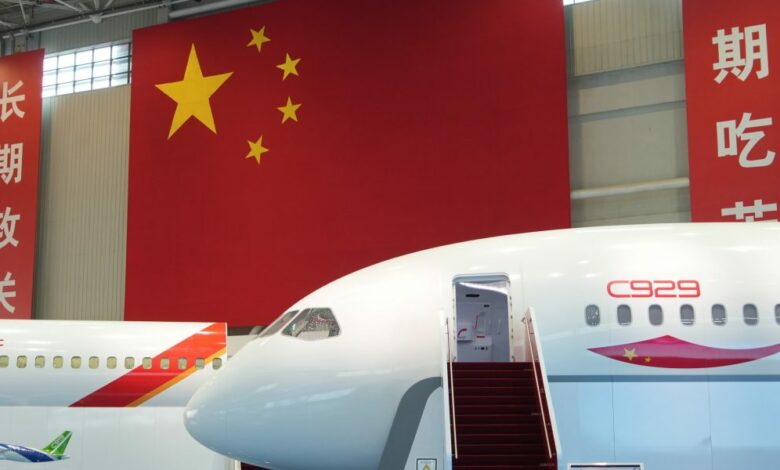COMAC can challenge Airbus, Boeing’s in the future—but it won’t be easy


When a panel flew out of its Alaska Airlines 737 Max 9 plane mid-air in January, the safety standards and leadership at Boeing became front-and-center. It’s since seen a slower pace of production and deliveries have further slipped behind for the market leader and its German rival, Airbus.
As the Seattle-based aircraft maker deals with the fallout from the accident while navigating its search for a new CEO, it’s prompted discussions on whether a third contender could fly into a global aviation market dominated by Airbus and Boeing—notably, Chinese state-backed COMAC.
The China-based airline maker has been working for well over a decade to build a challenger commercial aircraft that can shake up Boeing and Airbus’s stronghold. COMAC is still small, given that only five of its aircraft are flown by one of the country’s biggest carriers, China Eastern Airlines. But a shortage of planes amid high travel demand, shaky standing for Boeing, and C919’s grand debut in Singapore last month all point to an opening in the aviation market that could work in COMAC’s favor as it eyes a slice of the aviation pie.
What’s COMAC all about?
The Chinese group first began working on its narrowbody airliner in 2008, and production began three years after. Its C919 jets are now seen as possible competitors to Boeing’s 737s as well as Airbus’s 320 liners. They were certified by the aviation authority in China in Sep. 2022, and flew their first planes commercially within its home-country a year ago.
The aircraft maker’s goal has always been to unseat the two behemoths, and top airline industry executives have recognized COMAC’s potential as a competitor. In 2024, aviation consultancy IBA estimates that COMAC will deliver nine jets—that’s less than a third of Boeing’s monthly deliveries, pointing to the tall task the Chinese group faces.
But it’s already receiving more interest from airline companies, and could gain share within China and the rest of Asia before setting its eyes on the rest of the world.
“The challenges Boeing is facing have brought more focus on the opportunities that lie ahead for COMAC. The question is can COMAC take advantage of Boeing’s weakened position in the near-term?” Mike Yeomans, director of valuations and consulting at IBA, told Fortune.
IBA’s estimates point to COMAC grabbing 4% of global narrowbody deliveries, giving it a little over 1% of the market share by 2030. While that may take years to ramp up thereafter, it’s a start helped by Boeing’s uncertainties and the appetite for travel. Airbus has also benefited from these trends, as it’s gained market share amid the ongoing crisis.
Yeomans also noted that with Airbus and Boeing’s narrowbodies sold out for much of this decade, “the C919 has a strong opportunity to gain market share, particularly in its domestic market.”
It’s still unclear if Boeing’s woes have directly propped up demand for COMAC’s aircraft.
Will COMAC make strides… soon?
While there are more tailwinds for COMAC now than before, one of the biggest challenges for COMAC is getting certified by major authorities outside China. The China-based group’s influence is fairly limited for now especially because it isn’t certified with U.S. and European regulators, and that’s critical if it hopes to be “a credible threat to the current duopoly in the global narrowbody market” Yeomans said.
Another lingering question is whether COMAC is up to the challenge of scaling up production if demand grows.
“COMAC production rates have been far lower and inconsistent over time, and so we would not anticipate significant near-term ability to dramatically shift the dynamics,” John Mowry from Alton Aviation Consulting told Fortune, referring to the power dynamics between Airbus, Boeing and COMAC. However, he added that in the medium and long-term there’s scope for “significant demand” in the narrowbody aircraft market.
The mark COMAC makes with its current and upcoming customers in terms of quality control, timely delivery and more could also determine whether it has a future in breaking up the control shared by its German and American counterparts.
“The extent to which it displaces opportunities for Airbus and Boeing will depend on its in-service performance and reliability at launch operator China Eastern, and others as they start to take deliveries.”
All the skepticism aside, things are brewing at COMAC—it revealed two types of C919s that are in the works and received 50 jet orders from Tibet Airlines in February. It could be a while before COMAC breaks a duopoly up, but it seems to have gotten a tiny foot in the door for now.
Source link




